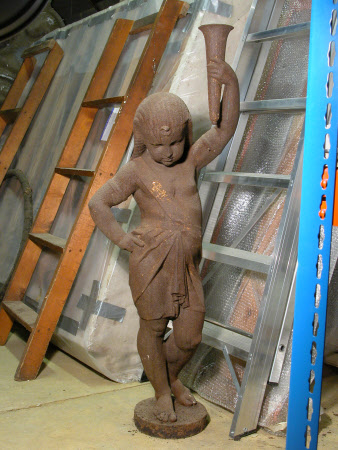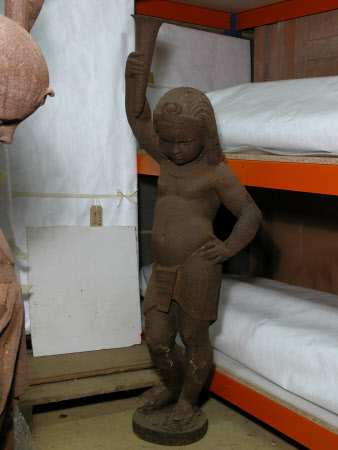A pair of torchères
Val D'Osne Foundry
Category
Art / Sculpture
Date
1870 - 1890
Materials
Parcel-gilt cast iron
Measurements
1180 x 450 x 240 mm
Place of origin
France
Order this imageCollection
Cliveden Estate, Buckinghamshire
NT 765997
Summary
Parcel-gilt cast iron, a pair of figural torchères in the Egyptian revival style, cast by Barbezat & Cie, Société Anonyme des Hauts-Fourneaux & Founderies du Val d'Osne, after a model by Mathurin Moreau, c. 1870-90, stamped on front of base BARBEZAT & CIE | VAL D'OSNE. A pair of cast iron figural torchères in the form of children, standing in contrapposto and looking down, raising gilt torches with one hand, the other hand resting on the hips. The children wear gilt shendyts (skirts) and jewelled armbands. The child at left wears a wig and diadem, the child at right a khat (headcloth) and diadem and an embossed sash.
Full description
Val d’Osne was a leading French art foundry that produced high-quality cast-iron ornaments throughout the 19th century and into the 20th. Established in 1835 by J.P. Andre Victor, the firm manufactured an extensive range of products from their Haute-Marne ironworks including candelabra and torchères, garden sculpture, architectural furnishings and fountains. Casts could be purchased from catalogues or from the company’s Paris showrooms. Val D’Osne expanded to buy out its competitors Barbezat & Cie and Ducel, taking on their pattern books. Barbezat was known for its collaborations with important artists and sculptors, including the academy sculptor Mathurin Moreau (1822-1912), the designer of the models for these Egyptian revival torchères. Moreau modelled for Barbezat and Val D’Osne from 1849 to 1879 and was a shareholder in the company. The torchères incorporate several stylistic motifs reflecting the fashions and cultural interests of the time. The figures themselves are modelled as children in the French academic style, but their pose and function ultimately derive from a much older European decorative tradition known as the ‘blackamoor’. In material culture this term was used to describe highly stylised and stereotyped representations of people from the continent of Africa, wearing exotic or orientalist costume, often assuming subservient or literally functional roles. The ‘blackamoor’ motif here is expressed in the Egyptian-revival style, with the children dressed in glittering gilt costumes of that epoch. European interest in Egypt was piqued during the Napoleonic invasion of 1798 to 1801 and the subsequent publication by the French government of the Description de l'Égypte (1809-22) which popularised Egyptian history and culture in Europe. Richly illustrated, the motifs and imagery reproduced in the Description were instrumental to the emergence of the Egyptian Revival style in European decorative arts and architecture. Artistic interest in Egypt and Arabic-speaking countries continued throughout the 19th century, as European powers expanded their colonial territories in North Africa and West Asia. The torchères were acquired by Hugh Grosvenor, 1st Duke of Westminster (1825-99), probably via the Barbezat agent in London. Grosvenor lived at Cliveden from 1868 to 1893. The torchères are mounted in the Duke’s Garden. An earlier cast of the model, c. 1864, is at Hughenden (NT 428756). Alice Rylance-Watson 2020
Makers and roles
Val D'Osne Foundry, foundry after Mathurin Moreau (Dijon 1822 - Paris 1912), sculptor
References
Davis 1991: John Davis, Antique Garden Ornament, 300 years of creativity: Artists, manufacturers & materials, Woodbridge 1991, pp. 275-80.

